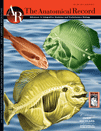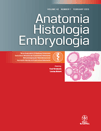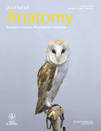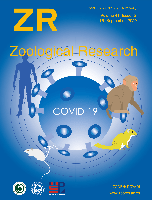
Anatomical Record-Advances in Integrative Anatomy and Evolutionary Biology
Scope & Guideline
Transforming Knowledge into Groundbreaking Discoveries.
Introduction
Aims and Scopes
- Comparative Anatomy:
Focuses on the anatomical differences and similarities among various species, enhancing our understanding of evolutionary relationships. - Functional Morphology:
Examines how anatomical structures relate to their functions, particularly in the context of locomotion, feeding, and sensory systems. - Paleobiology and Evolutionary Anatomy:
Integrates paleontological findings with anatomical studies to elucidate the evolutionary history of various taxa. - Developmental Biology:
Investigates the ontogeny of anatomical structures, providing insights into how anatomical forms arise and change throughout the life cycle. - Histology and Microanatomy:
Focuses on the microscopic structure of tissues and organs, exploring their functional implications and evolutionary adaptations. - Innovative Imaging Techniques:
Utilizes advanced imaging technologies such as micro-CT and 3D reconstructions to analyze anatomical structures in detail.
Trending and Emerging
- Integrative Approaches to Anatomy:
There is a growing trend towards integrating anatomical studies with fields such as ecology, genetics, and evolutionary biology, emphasizing the interconnectedness of biological systems. - Use of Advanced Imaging Techniques:
The application of innovative imaging methods, such as high-resolution micro-CT and 3D visualization, is on the rise, allowing for more detailed anatomical analyses. - Comparative Functional Anatomy:
Emerging research increasingly focuses on the functional implications of anatomical features across different species, particularly in relation to locomotion and feeding strategies. - Evolutionary Developmental Biology (Evo-Devo):
The integration of developmental biology with evolutionary theory is gaining traction, exploring how developmental processes influence anatomical diversity and evolutionary change. - Anatomical Studies in Conservation Biology:
Research that links anatomical knowledge with conservation efforts is becoming more prominent, particularly in understanding species adaptations and responses to environmental changes. - Neuroanatomy and Behavior:
There is an increasing interest in the relationship between neuroanatomical structures and behaviors in various species, particularly in understanding sensory systems and cognitive functions.
Declining or Waning
- Traditional Morphometrics:
There has been a noticeable decline in studies relying solely on traditional morphometric methods, as researchers increasingly adopt more sophisticated imaging techniques and computational analyses. - Focus on Single Species Studies:
The journal is seeing fewer papers concentrating exclusively on the anatomy of single species, with a shift towards comparative studies that place individual species within broader evolutionary contexts. - Descriptive Anatomy Without Evolutionary Context:
Papers that provide purely descriptive anatomical data without discussing evolutionary implications are becoming less common, as the emphasis shifts towards integrative and comparative approaches. - Histopathology in Isolated Contexts:
There is a reduction in studies that focus solely on histopathological aspects without connecting them to functional or evolutionary interpretations.
Similar Journals

FLORA
Exploring the Depths of Plant Science and EcologyFLORA is a distinguished journal published by Elsevier GmbH, focusing on the realms of Ecology, Plant Science, and Evolutionary Biology. Established in 1975, this journal has been a vital platform for researchers and professionals, disseminating groundbreaking findings and insights relevant to the plant sciences. With an impressive impact factor and a current Scopus ranking placing it in the second quartile (Q2) across multiple categories, FLORA is recognized as a critical resource for advancing knowledge in its respective fields. The journal publishes both traditional research articles and significant review papers, ensuring a broad spectrum of academic engagement. Although not open access, FLORA remains committed to enhancing the scientific discourse and fostering collaboration among scholars worldwide. Researchers seeking to enrich their understanding of ecological dynamics and plant biology will find FLORA to be an essential addition to their academic repertoire.

ANATOMIA HISTOLOGIA EMBRYOLOGIA
Pioneering Research in Veterinary and Medical SciencesANATOMIA HISTOLOGIA EMBRYOLOGIA, published by Wiley, is a well-regarded journal that serves as a vital resource in the field of anatomy and histology, with a particular emphasis on embryological studies. Established in 1972, this journal fosters cutting-edge research and discussions that deepen our understanding of the intricate relationships between structure and function across various species, while also addressing the parallels within veterinary and medical contexts. Though currently not open access, the journal maintains a significant impact within its scope, evidenced by its strong performance in Scopus rankings, particularly in the veterinary sciences, where it stands at rank #81 out of 194. With its dedicated focus on progressive scientific inquiry and publication regularly until 2024, the journal is committed to advancing knowledge and providing a platform for scholars, researchers, and practitioners alike. ANATOMIA HISTOLOGIA EMBRYOLOGIA is pivotal for those aiming to engage with the latest findings and methodologies in the fields of medicine and veterinary science, ensuring it remains an essential addition to any academic library.

ZOOLOGICAL JOURNAL OF THE LINNEAN SOCIETY
Exploring the depths of animal science and ecology.Zoological Journal of the Linnean Society, published by Oxford University Press, stands as a prestigious vessel for scholarly discourse in the fields of Animal Science and Ecology. With an ISSN of 0024-4082 and E-ISSN 1096-3642, this journal has an illustrious history dating back to its inception in 1866, and has consistently contributed groundbreaking research that shapes our understanding of zoology and evolutionary biology. Operating out of the United Kingdom, the journal boasts an impressive Q1 ranking in both Animal Science and Zoology and Ecology, Evolution, Behavior and Systematics, positioning it among the top tier of its category. With a significant presence in the academic landscape, the journal ranks 24th among 490 in Animal Science and 97th among 721 in Ecology, reflecting its impact and relevance in the field. Although it is not an open access journal, the wealth of knowledge it offers is invaluable for researchers, professionals, and students alike, aiding in the advancement of zoological sciences.

ACTA ZOOLOGICA
Unveiling Insights into Animal BiologyACTA ZOOLOGICA, published by WILEY, is a distinguished journal that serves as an essential resource for researchers and professionals in the fields of Animal Science, Zoology, Cell Biology, and Ecology. With its ISSN 0001-7272 and E-ISSN 1463-6395, this journal has been contributing to the scientific community since 1920 and continues to explore new dimensions in zoological research. As of 2023, it holds an impactful position with a Q3 ranking in Animal Science and Zoology as well as Ecology, Evolution, Behavior and Systematics, signifying its relevance and emerging influence in these domains. Although it is not an Open Access journal, ACTA ZOOLOGICA remains committed to disseminating high-quality research and facilitating scholarly discussions among its audience. The journal aims to publish original articles, reviews, and critical findings that enhance understanding of animal biology and conservation, addressing global ecological challenges. Its rankings in Scopus further underscore its scholarly reputation, making it a valuable addition to the libraries of institutions and individuals alike.

ARCHIV FUR MOLLUSKENKUNDE
Exploring the Depths of Molluscan ScienceARCHIV FUR MOLLUSKENKUNDE, published by E SCHWEIZERBARTSCHE VERLAGSBUCHHANDLUNG, is a premier journal dedicated to the study of mollusks, covering a broad spectrum of topics from taxonomy and ecology to conservation and biodiversity. With its commitment to advancing knowledge and fostering collaboration within the malacological community, this journal serves as an essential resource for researchers, professionals, and students alike. Though it is not currently operated under an open-access model, it provides valuable insights and the latest findings in the field, making it indispensable for those involved in mollusk research. Scholars can access the journal's rich repository of articles, ensuring their work remains at the forefront of scientific inquiry. The journal operates out of Stuttgart, Germany, further emphasizing its European scholarly tradition in the environmental and biological sciences.

JOURNAL OF ANATOMY
Fostering Innovative Discourse in Anatomical ResearchThe JOURNAL OF ANATOMY, published by Wiley, is a premier international journal dedicated to advancing the field of anatomy and its related disciplines. With the ISSN 0021-8782 and E-ISSN 1469-7580, this esteemed journal has been at the forefront of anatomical research since its inception in 1945. Renowned for its rigorous peer-review process, the journal has earned a prestigious impact factor reflecting its high standard of scholarly work. This includes a 2023 Quartile ranking of Q1 in Anatomy, underscoring its prominence among top-tier publications. The journal’s diverse scope encompasses key fields such as cell biology, developmental biology, and molecular biology, making it an essential resource for researchers and practitioners alike. Publishing cutting-edge research and reviews, the JOURNAL OF ANATOMY aims to foster innovative scientific discourse and exploration within the anatomical sciences, solidifying its role as a vital hub for the global anatomical community.

JOURNAL OF CONCHOLOGY
Exploring the Depths of Conchological ResearchJOURNAL OF CONCHOLOGY, published by the Conchological Society of Great Britain & Ireland, is a prominent academic journal focused on the study of mollusks, specifically their taxonomy, ecology, and evolutionary biology. Through its rigorous peer-review process, it aims to provide a platform for significant research in the field, fostering deeper understanding and appreciation of these diverse organisms. Although it is not currently an Open Access journal, its publications contribute notably to the fields of Agricultural and Biological Sciences, notably in Ecology, Evolution, Behavior and Systematics and Aquatic Science, as indicated by its rankings in Scopus. The journal's archives trace comprehensive coverage from 1981 to 1990 and from 1996 to 2018. With its commitment to advancing conchological knowledge, the JOURNAL OF CONCHOLOGY serves as a crucial resource for researchers, professionals, and students invested in the biological and ecological dimensions of mollusk studies.

HOMO-JOURNAL OF COMPARATIVE HUMAN BIOLOGY
Bridging Gaps in Anthropological UnderstandingHOMO - Journal of Comparative Human Biology is a prestigious academic journal dedicated to advancing the field of comparative human biology, offering a platform for researchers, professionals, and students to disseminate cutting-edge findings. Published by E Schweizerbart'sche Verlagsbuchhandlung in Germany, this journal has been a crucial resource since its inception in 1950, featuring a rich archive of studies until 2023. It holds a Q3 quartile ranking in Anthropology and a Q4 quartile ranking in Miscellaneous Medicine, reflecting its significance and influence within the academic community. Although not an Open Access journal, it provides a wealth of robust research that intersects with various disciplines within the anthropological sciences. Researchers looking for a wide array of comparative studies and insights into human biology will find HOMO an invaluable addition to their scholarly resources.

FOLIA MORPHOLOGICA
Exploring the Depths of Anatomical ResearchFOLIA MORPHOLOGICA is a prominent academic journal dedicated to advancing the fields of anatomy and histology. Published by VIA MEDICA since 1952, this journal serves as a critical platform for the dissemination of high-quality research, offering valuable insights into morphological studies. With an impact factor reflective of its dedication to rigorous scientific evaluation, FOLIA MORPHOLOGICA is recognized within the Q3 category in both anatomy and histology as of 2023, indicating its substantial contribution to these vital areas of medical science. Although currently not an open-access journal, it provides essential access options through various academic databases, ensuring that important findings are reachable by researchers, healthcare professionals, and students globally. The journal's scope encompasses a wide range of topics related to morphological sciences, making it a vital resource for those looking to stay at the forefront of anatomical and histological research. FOLIA MORPHOLOGICA remains dedicated to fostering scholarly communication and innovation, continuously aiming to enhance the scientific understanding of the intricate structures that underpin biological functions.

ZOOLOGICAL RESEARCH
Connecting Global Minds in Animal ResearchZoological Research, published by Science Press, stands as a premier open-access journal in the fields of animal science, zoology, and ecology. Since its inception in 1980, it has fostered an inclusive platform for innovative research and dialogue within the scientific community, enabling researchers from across the globe to share their findings and insights. The journal's significant impact is underscored by its classification in the Q1 quartile across multiple categories, including Animal Science and Zoology, Ecology, and Nature Conservation for 2023, as well as its impressive rankings within Scopus, placing it in the top tier of its respective fields. Situated in Beijing, China, Zoological Research not only contributes to advancing knowledge but also emphasizes the critical importance of conservation practices in today’s rapidly changing ecosystems. With its commitment to open access, researchers, educators, and students alike benefit from immediate, unrestricted access to vital scientific information, making it an essential resource for anyone involved in the biological sciences.